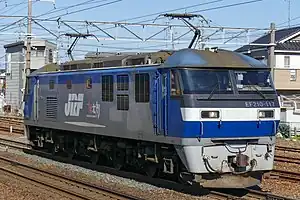| Class DF200 | |||||||||||||||||||||||||||
|---|---|---|---|---|---|---|---|---|---|---|---|---|---|---|---|---|---|---|---|---|---|---|---|---|---|---|---|
 DF200-901 and DF200-6 in January 2008 | |||||||||||||||||||||||||||
| |||||||||||||||||||||||||||
| |||||||||||||||||||||||||||
| |||||||||||||||||||||||||||
| |||||||||||||||||||||||||||
The Class DF200 (DF200形) is a Bo-Bo-Bo wheel arrangement diesel-electric locomotive type operated by the Japan Freight Railway Company (JR Freight)[1] and the Kyushu Railway Company.
As of 1 March 2017, JR Freight operates 48 Class DF200s, and JR Kyushu operates one (DF200-7000).[2]
Variants
- DF200-900
- DF200-0
- DF200-50
- DF200-100
- DF200-200
- DF200-7000 (JR Kyushu)
DF200-900
The pre-production locomotive DF200-901 was delivered in March 1992 for testing. It has two MTU 12V396TE14 diesel engines.[1]
 DF200-901 in December 2012
DF200-901 in December 2012
DF200-0
Full-production batch delivered from 1994. Red "JRF" logos were later replaced by white logos. 12 locomotives were built.[1]
 DF200-3 in October 2012
DF200-3 in October 2012
DF200-50
Batch built from March 2000 with Komatsu SDA12V170-1 diesel engines in place of the earlier MTU engines. External changes include grey front-end skirts, white "JRF" logos, and "Red Bear Eco Power" logos. 13 locomotives were built.[1]
 DF200-52 in October 2009
DF200-52 in October 2009
DF200-100
Batch built from August 2005 to December 2011 with IGBT VVVF inverters.[1] 23 Class DF200-100 locomotives were built.[3]
 DF200-105 in October 2011
DF200-105 in October 2011
DF200-200
In 2016, DF200-123 was moved from Hokkaido to Suita Depot in Osaka,[4] where it underwent modifications and renumbering to DF200-223 before being returned to service on the Kansai Main Line in the Nagoya area.[2][5] This was followed by locomotives DF200-116 and DF200-120, which were similarly modified and renumbered DF200-216 and DF200-220 respectively in 2018.[6]
DF200-7000

A dedicated Class DF200-7000 diesel locomotive was built in 2013 for JR Kyushu's Seven Stars in Kyushu luxury excursion train. Built specially for use in Kyushu and finished in a deep maroon livery, the locomotive was built by Kawasaki Heavy Industries in Kobe, and delivered in July 2013.[7][8]
Classification
The DF200 classification for this locomotive type is explained below.
- D: Diesel locomotive
- F: Six driving axles
- 200: Diesel-electric locomotive with AC motors
References
- 1 2 3 4 5 JR全車輌ハンドブック2006 [JR Rolling Stock Handbook 2006]. Japan: Neko Publishing. 2006. ISBN 978-4-7770-0453-9.
- 1 2 Kisumi, Kenzo (April 2017). 世代交代が進むJR貨物の機関車 [Advances in handover between generations for JR Freight locomotives]. Tetsudo Club (in Japanese). Vol. 2. Japan: Cosmic Publishing. pp. 98–100. ISBN 978-4-7747-8338-3.
- ↑ JR車両ファイル2012 [JR Rolling Stock File 2012]. Japan Railfan Magazine. Vol. 52, no. 615. Japan: Kōyūsha Co., Ltd. July 2012. p. 64.
- ↑ DF200-123が吹田機関区へ [DF200-123 moved to Suita Depot]. Japan Railfan Magazine Online (in Japanese). Japan: Koyusha Co., Ltd. 22 January 2016. Retrieved 27 May 2016.
- ↑ JR車両ファイル2016 [JR Rolling Stock File 2016]. Japan Railfan Magazine (in Japanese). Vol. 56, no. 663. Japan: Koyusha Co., Ltd. July 2016. p. 56.
- ↑ DF200-220が出 [DF200-220 outshopped]. Japan Railfan Magazine Online (in Japanese). Japan: Koyusha Co., Ltd. 7 February 2018. Archived from the original on 9 February 2018. Retrieved 9 February 2018.
- ↑ JR九州「ななつ星in九州」の概要を発表 [JR Kyushu announces details of "Seven Stars in Kyushu"]. Railway Journal (550): 146. August 2012.
- ↑ ななつ星の機関車完成、いざ九州へ [Seven Stars locomotive completed and delivered to Kyushu]. Yomiuri Online (in Japanese). Japan: The Yomiuri Shimbun. 2 July 2013. Archived from the original on 2013-07-07. Retrieved 2 July 2013.
External links
- JR Freight website (in Japanese)
- Details on Kawasaki Heavy Industries website (in Japanese)
